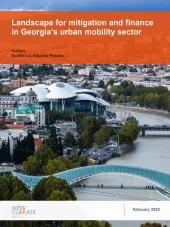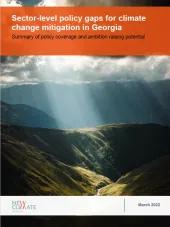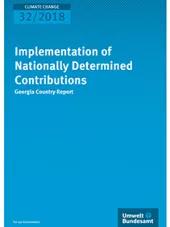Georgia is at an important crossroad with regards to the short-, medium- and long-term future of infrastructure and investment in the transport sector. Transport is a key sector for Georgia’s Climate Strategy and Action Plan (CSAP), which was prepared for parliamentary consideration in 2020 alongside Georgia’s updated Nationally Determined Contribution (NDC) to the Paris Agreement. These documents were partially informed by the analysis compiled in this report, which supported the transport sector to identify actions for reducing emissions. This report explores several emission pathway scenarios for Georgia’s transport sector, in the context of the challenges currently faced in the sector, and the implications of international climate commitments and national development objectives.
Main findings:
The transport sector constitutes one of the largest sources of greenhouse gas emissions in Georgia. In 2015, the transport sector was responsible for emissions of 4.2 MtCO2e, approximately 24% of total national emissions. We model several policy scenarios: Under a business-as-usual reference scenario, GHG emissions from the sector are projected to increase by 71% to 7.1 MtCO2e in 2030.
- Freight transport is projected to be the sub-sector with the largest growth in the reference scenario, with GHG emissions more than doubling due to the high projected increase in commercial activity.
- The GHG emissions projection for freight transport depends heavily on the extent to which freight activity can be shifted from road-based heavy goods vehicles to rail, and the rate at which the rail can be electrified.
- A 49% growth in GHG emissions from passenger transport between 2015 and 2030 is roughly in line with the expected increase in passenger activity demand over the same period, as improvements in the emission intensities of vehicles are projected to be offset by an increase in the proportion of passenger activity in private light duty vehicles.
Under the CSAP scenario where Georgia fully implements mitigation actions in the Climate Strategy and Action Plan, GHG emissions from the sector are projected to increase by 34% to 5.6 MtCO2e in 2030.
- While freight transport emissions maintain the same upward trajectory in the CSAP scenario as in the reference case, the trend for passenger transport emissions is reversed and leads to a 7% decrease in absolute emissions between 2015 and 2030.
- The modal share for LDVs drops significantly between 2015 and 2030 by 14.8%, while the share for buses almost doubles. The modal share for rail and marshutkas also increases by 2.5% and 4.3% respectively.
Emissions for the transport sector under “Best-in-class” and “Paris Agreement-compatible” scenarios peak in the short term and decline towards zero in mid-century. A Paris compatible GHG emission trajectory would require a considerable shift away from current pathways and practices. The report contains a sector-wide mapping of policy gaps, institutional governance frameworks, and has the following observations and recommendations:
Awareness of the implications of the Paris Agreement for the transport sector and the synergies with development objectives could be increased. Awareness of these specific commitments and implications is not widespread amongst various transport sector stakeholders. Efforts to decarbonise the transport sector would be fully in-line with and mutually reinforcing other national strategic objectives, including the EU Association Agreement and the Agenda 2030 Sustainable Development Goals (SDGs). Enhanced awareness of these links amongst transport sector stakeholders and national development strategists can assist to identify the most constructive options for Georgia.
The establishment of a permanent coordinated planning process for the transport sector could ensure that policies, strategies, and data are better aligned between the various institutions jurisdiction over transport-related issues, including various national government departments and municipal governments. Such a process should be established with permanence, to support the development of transport sector plans and strategies in the future, without needing to start from the beginning with the resource-intensive exercise of compiling an overview of the fragmented actions and plans from those various institutions. In the best-case, a centralised institution would be identified to assume overarching responsibility for transport sector strategy, so that the coordinated sector structure model could be pursued (see section 5.4).
Improved transport activity data collection would improve the accuracy of trajectory projections and the quality of policy formulation. The scenarios in this report are based upon the best available data and knowledge from national experts, but there are considerable uncertainties and knowledge gaps that may compromise the accuracy of activity and emission projections.
Georgia should proceed to draft policies and international climate finance proposals for high-potential measures that are ready to be implemented. Despite uncertainties and data gaps, multiple options for enhanced action exist and are clear; stakeholders of the sector working group for the Climate Strategy and Action Plan discussed and prioritised these areas for further action (see section 5.2). For some priority areas, policy-specific analysis should be executed to determine the best regulatory instruments and policy design options, while for other areas it is already possible to proceed to draft policies and international climate finance proposals where necessary.







